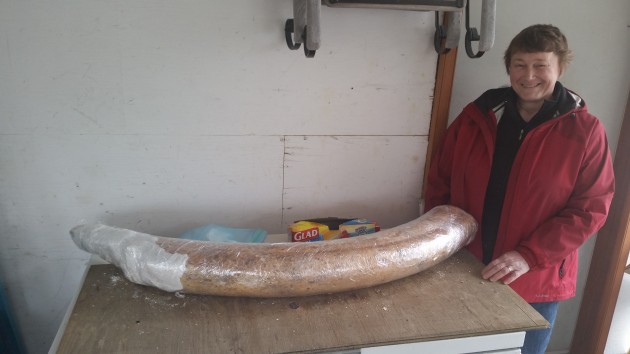Discovery of ‘Mammoth’ Proportions in Peace Region
Thelma Ostero stands beside mammoth tusk she discovered- image courtesy Peace Region Paleontology Research Centre
Tumbler Ridge, B.C. – The Peace Region Paleontology Research Centre in Tumbler Ridge has a new star acquisition: a mammoth tusk.
The tusk, was unearthed in a gravel pit at the end of April in the North Peace Region.
Nearly two metres (6’6″) long and weighing about 25 kgs (about 55 pounds), the tusk was discovered by Tom and Thelma Ostero who quickly donated it to the museum.
Rich McCrea, Curator of Paleontology says the first order of business for the tusk is to ensure it is protected from the elements. Without protection, McCrea says this kind of specimen could fall apart from the inside out. ” It’s been in its environment for probably a few tens of thousands of years, and it’s recently been exposed to what, for it, is an alien environment, so it can fall apart within a few days a couple of weeks at the most.” He says preservation will mean folks can see this tusk in a hundred years from now.”
While a small piece of the tusk will be sent to be carbon dated, McCrea estimates it could be at least 10 thousand years old, perhaps as old as 40 thousand years.
He says the find is important “This is the first major specimen, first major mammoth tusk to be found in the Peace region that stayed in the Peace region. There have been other finds that have gone to other museums in other provinces, and that’s one of the roles of our museum, is to slow that hemorrhage of specimens out of the province and have it on display for the education and interest of the locals and tourists who come to visit, Also , there’s a big research interest in that as well because specimens like this tell us about ancient environments and the animals that walked around back in the ice age, and possibly if there was any First Nations interaction with them.”
The site where the tusk was discovered is not being explored for other pieces, “There would be no point, given the nature of the depositional environment, it’s unlikely to yield more at that particular level in the pit” but people in the area have promised to be on the look out for any other interesting finds.
With the exception of the end of the tusk, the specimen is said to be “in an excellent state of preservation” .
McCrea says the people in the region have been very good to report and donate their findings “I am so impressed with people’s attitudes in this region that when they do find something, more often than not, they report it and I’m not just talking about individuals, I’m talking about industry, there is quite a lot of cooperation and mutual interest in that. People are curious about the origins and what these finds might mean.”


Comments
pretty big job for the tooth fairy.
very exciting!
Very cool to see. I wonder what that would have gotten on ebay! It’s nice that people donate rather than profit from their findings.
First Nation interaction, yep, RUN.
And why is that, exactly?
Comments for this article are closed.